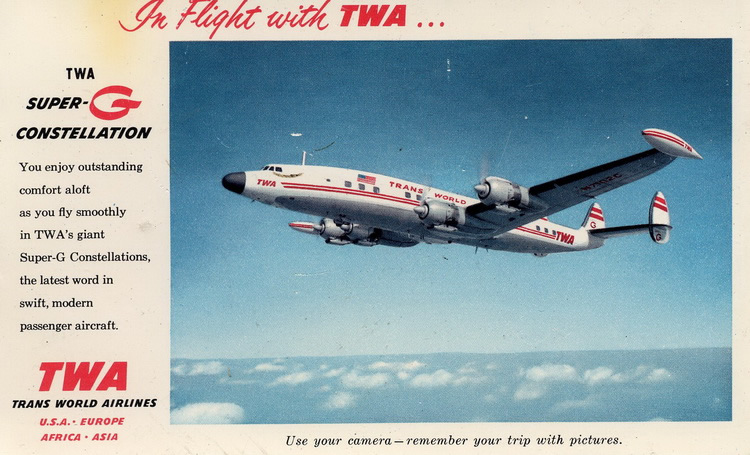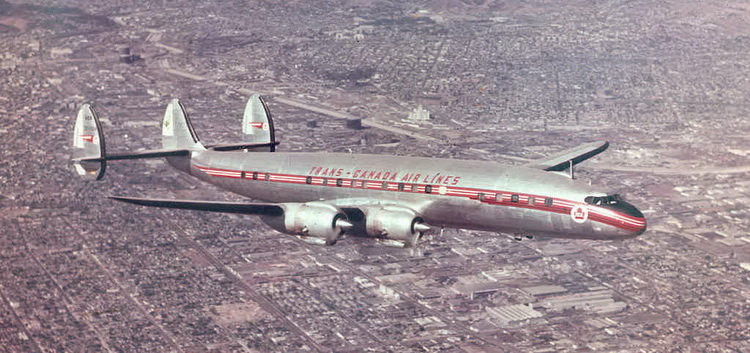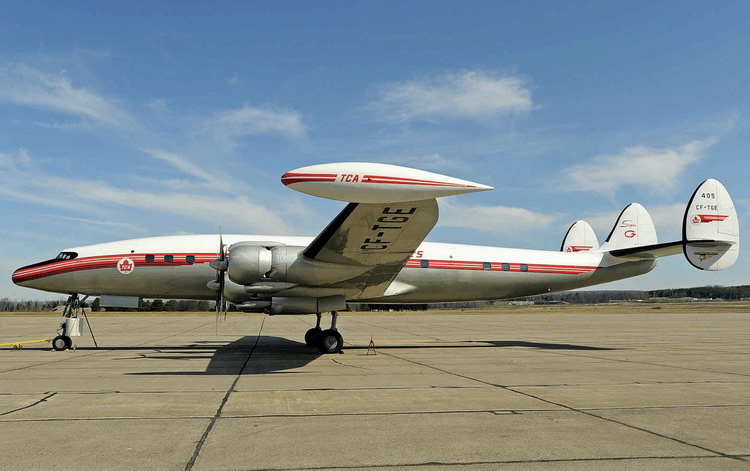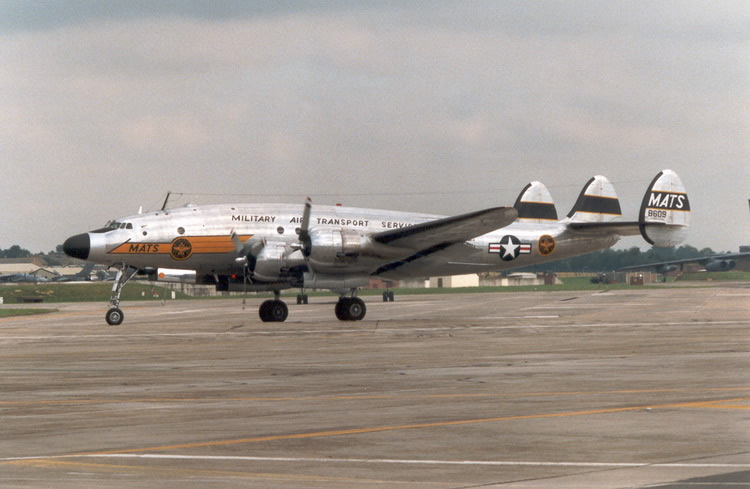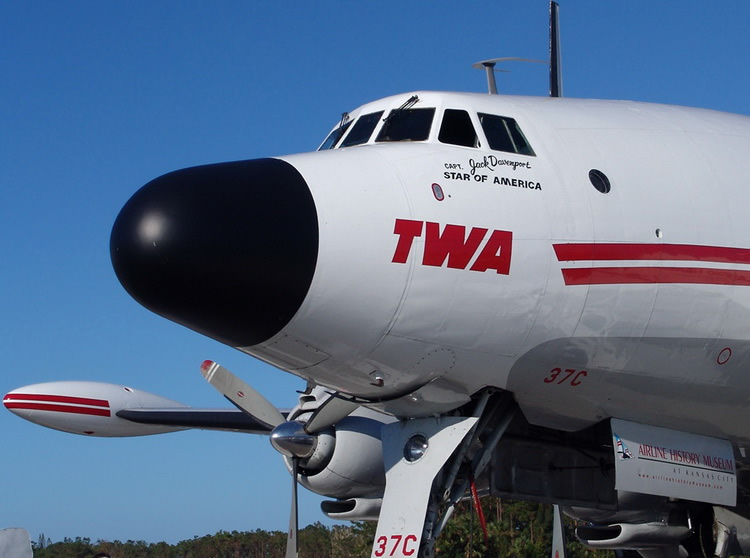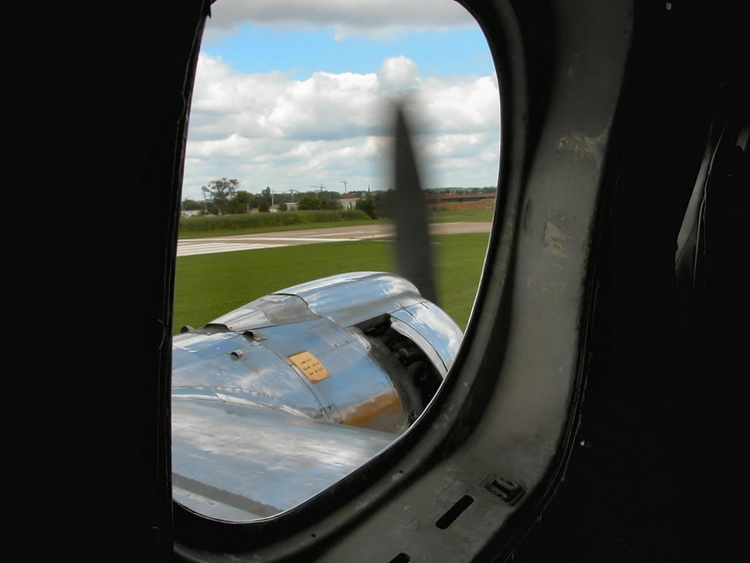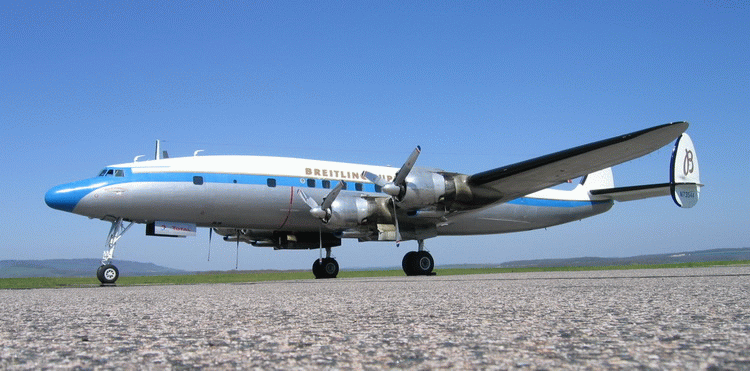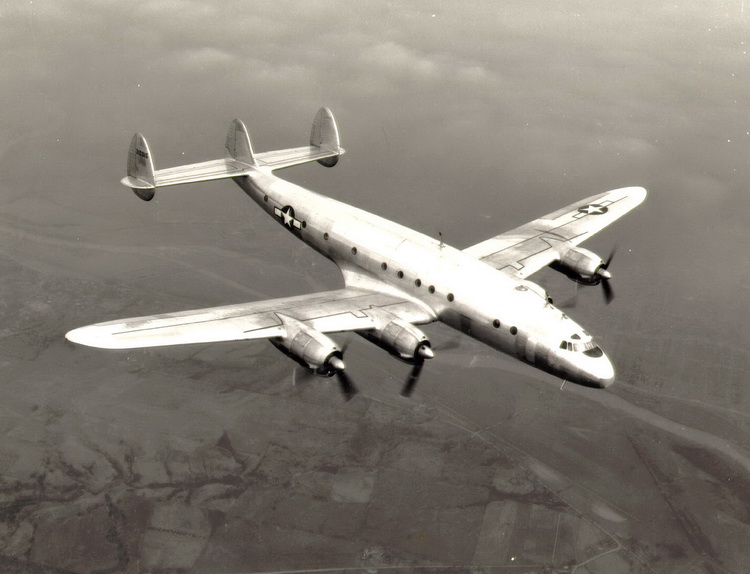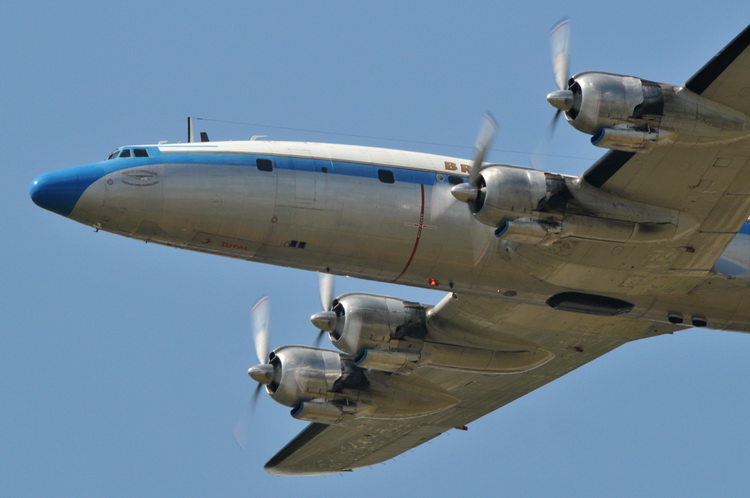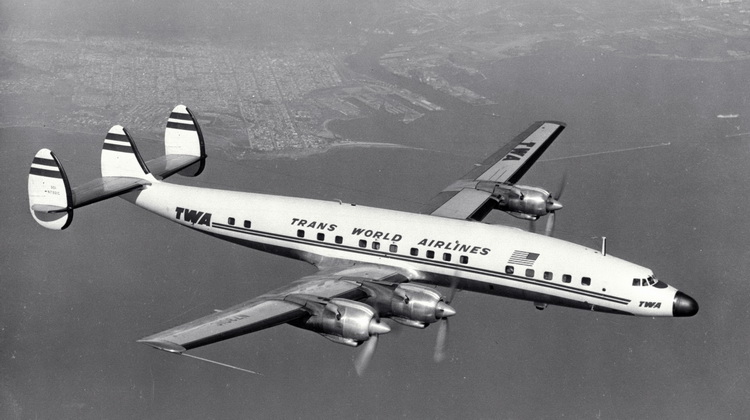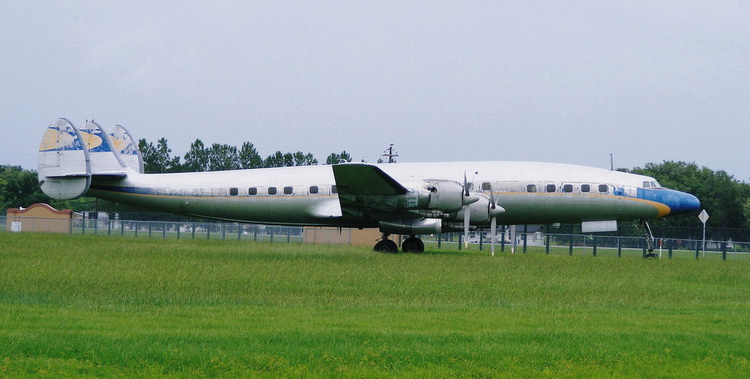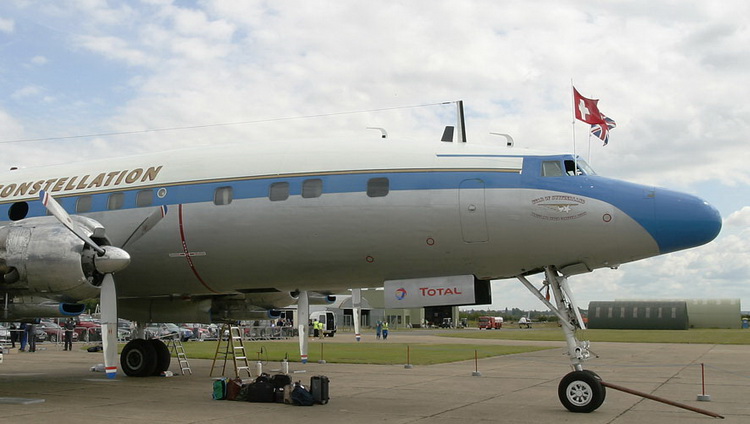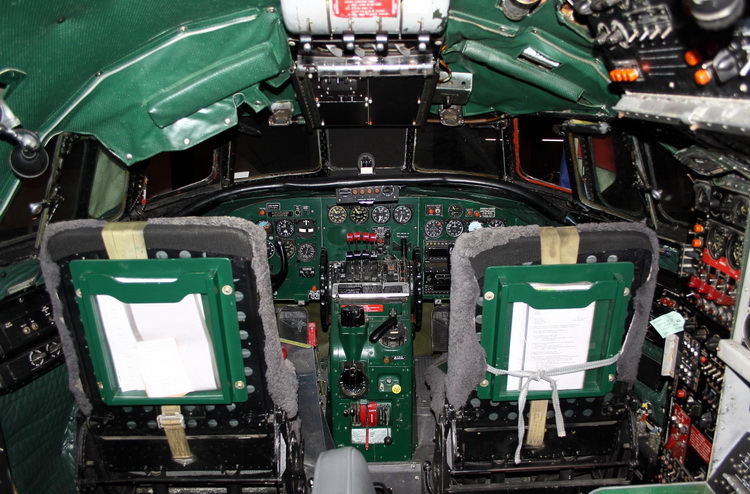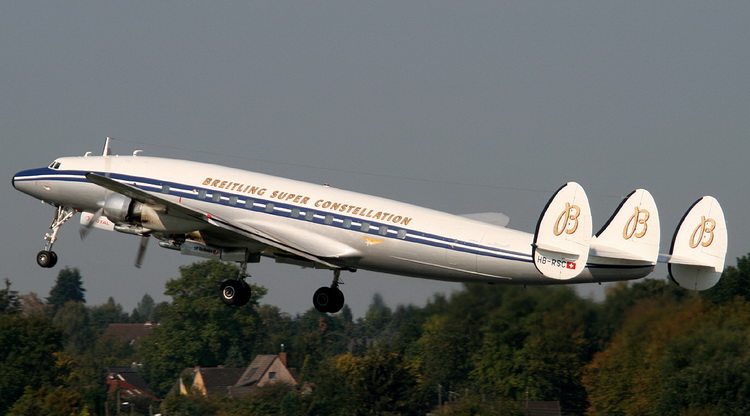LOCKHEED CONSTELLATION L-049 CONNIE PROP PLANE
AIRCRAFT HISTORY INFORMATION PICTURES AND FACTS
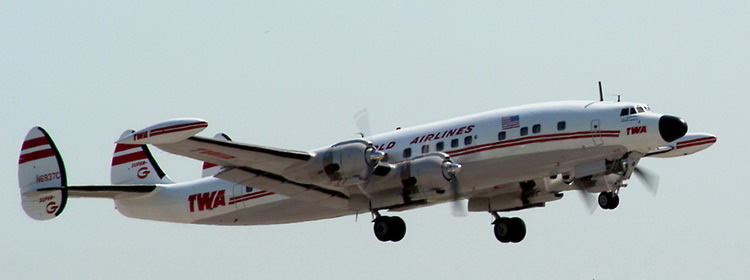 |
TWA Airlines Lockheed Constellation 4 Prop Airliner
The Lockheed Constellation ("Connie") was a propeller-driven airliner powered by four 18-cylinder radial Wright R-3350 engines. It was built by Lockheed between 1943 and 1958 at its Burbank, California, facility.A total of 856 aircraft were produced in numerous models, all distinguished by a triple-tail design and dolphin-shaped fuselage. The Constellation was used as a civilian airliner and as a U.S. military air transport, seeing service in the Berlin Airlift. It was the presidential aircraft for U.S. President Dwight D. Eisenhower.
Since 1937 Lockheed had been working on the L-044 Excalibur, a four-engine pressurized airliner. In 1939 Trans World Airlines, at the instigation of major stockholder Howard Hughes, requested a 40-passenger transcontinental airliner with 3,500 mi (5,630 km) range well beyond the capabilities of the Excalibur design. TWA's requirements led to the L-049 Constellation, designed by Lockheed engineers including Kelly Johnson and Hall Hibbard. Willis Hawkins, another Lockheed engineer, maintains that the Excalibur program was purely a cover for the Constellation.
The Constellation's wing design was close to that of the P-38 Lightning, differing mostly in scale. The distinctive triple tail kept the aircraft's overall height low enough to fit in existing hangars, while new features included hydraulically boosted controls and a thermal de-icing system used on wing and tail leading edges. The aircraft had a top speed of over 340 mph (550 km/h), faster than that of a Japanese Zero fighter, a cruise speed of 300 mph (480 km/h), and a service ceiling of 24,000 ft (7,300 m).
According to Anthony Sampson in Empires of the Sky, the intricate design may have been undertaken by Lockheed, but the concept, shape, capabilities, appearance and ethos of the Constellation were driven by Hughes' intercession during the design process.
With the onset of World War II, the TWA aircraft entering production were converted to an order for C-69 Constellation military transport aircraft, with 202 aircraft intended for the United States Army Air Forces (USAAF). The first prototype (civil registration NX25600) flew on January 9, 1943, a short ferry hop from Burbank to Muroc Field for testing. Edmund T. "Eddie" Allen, on loan from Boeing, flew left seat, with Lockheed's own Milo Burcham as copilot. Rudy Thoren and Kelly Johnson were also on board.
Lockheed proposed the model L-249 as a long range bomber. It received the military designation XB-30 but the aircraft was not developed. A plan for a very long-range troop transport, the C-69B (L-349, ordered by Pan Am in 1940 as the L-149), was canceled. A single C-69C (L-549), a 43-seat VIP transport, was built in 1945 at the Lockheed-Burbank plant.
The C-69 was mostly used as a high-speed, long-distance troop transport during the war. A total of 22 C-69s were completed before the end of hostilities, but not all of these entered military service. The USAAF cancelled the remainder of the order in 1945.
After World War II the Constellation came into its own as a popular, fast, civilian airliner. Aircraft already in production for the USAAF as C-69 transports were finished as civilian airliners, with TWA receiving the first on 1 October 1945. TWA's first transatlantic proving flight departed Washington, DC, on December 3, 1945, arriving in Paris on December 4 via Gander and Shannon.
Trans World Airlines transatlantic service started on February 6, 1946 with a New York-Paris flight in a Constellation. On June 17, 1947 Pan American World Airways opened the first ever regularly scheduled round-the-world service with their L-749 Clipper America. The famous flight "Pan Am 1" operated until 1982.
As the first pressurized airliner in widespread use, the Constellation helped to usher in affordable and comfortable air travel. Operators of Constellations included TWA, Eastern Air Lines, Pan American World Airways, Air France, BOAC, KLM, Qantas, Lufthansa, Iberia Airlines, Panair do Brasil, TAP Portugal, Trans-Canada Air Lines (later renamed Air Canada), Aer Lingus, VARIG, Cubana de Aviación and Línea Aeropostal Venezolana.
The Constellation had three accidents in the first 10 months of service, temporarily curtailing its career as a passenger airliner. On June 18, 1946, an engine of a Pan American aircraft caught fire and fell off. The flight crew made an emergency landing with no loss of life. The same aircraft made a return flight across America in 11 1/2 hours for repairs using only three engines. However, on July 11, a Transcontinental and Western Air aircraft fell victim to an in-flight fire, crashing in a field and taking the lives of five of the six on board. The accidents prompted the suspension of the Constellation's airworthiness certificate until Lockheed could modify the design. This was dramatized in the motion picture The Aviator (2004) during the scene where Howard Hughes (played by Leonardo DiCaprio) surveys numerous grounded TWA Constellations.
The Constellation proved prone to engine failures, earning the nickname "World's Finest Trimotor" in some circles. Sleek and powerful, Constellations set a number of records. On April 17, 1944, the second production C-69, piloted by Howard Hughes and TWA president Jack Frye, flew from Burbank, California, to Washington, D.C., in 6 hours and 57 minutes (c. 2,300 mi/3,701 km at an average 330.9 mph/532.5 km/h). On the return trip, the aircraft stopped at Wright Field to give Orville Wright his last flight, more than 40 years after his historic first flight. He commented that the Constellation's wingspan was longer than the distance of his first flight.
On September 29, 1957, an L-1649A Starliner flew from Los Angeles to London in 18 hours and 32 minutes (about 5,420 mi/8,723 km at 292.4 mph/470.6 km/h). The L-1649A holds the record for the longest-duration, non-stop passenger flight. During TWA's inaugural London-to-San Francisco flight on October 1–2, 1957, the aircraft stayed aloft for 23 hours and 19 minutes (about 5,350 mi/8,610 km at 229.4 mph/369.2 km/h).
The advent of jet airliners, with the de Havilland Comet, Boeing 707, Douglas DC-8 and Convair 880, rendered the piston-engined Constellation obsolete. The first routes lost to jets were the long overseas routes, but Constellations continued to fly domestic routes. The last scheduled passenger flight in the 48 states was made by a TWA L749 on May 11, 1967, from Philadelphia to Kansas City, Missouri. However, Constellations remained in freight service for years to come, and were used on backup sections of Eastern Airlines' shuttle service between New York, Washington, and Boston until 1968. An Eastern Constellation to date still holds the record for a New York to Washington flight from lift off to touch-down in just over 30 minutes. The record was set prior to speed restriction by the FAA below 10,000 ft.
One of the reasons for the elegant appearance of the aircraft was the fuselage shape—a continuously variable profile with no two bulkheads the same shape. Unfortunately, this construction is very expensive and was replaced by the mostly tube shape of modern airliners. The tube is more resistant to pressurization changes and cheaper to build. With the shutdown of Constellation production, Lockheed elected not to develop a first-generation jetliner, instead sticking to its lucrative military business and production of the modest turboprop-powered Lockheed L-188 Electra airliner. Lockheed would not build a large civil passenger aircraft again until its L-1011 Tristar debuted in 1972. While a technological marvel, the L-1011 was a commercial failure, and Lockheed left the commercial airliner business permanently in 1983. The initial military versions carried the Lockheed designation of L-049; as World War II came to a close, some were completed as civil L-049 Constellations followed by the L-149 (L-049 modified to carry more fuel tanks). The first purpose-built passenger Constellation was the more powerful L-649 and L-749 (which had more fuel in the outer wings), L-849 (an unbuilt model to use the R-3350 TurboCompound engines adopted for the L-1049 ), L-949 (an unbuilt, high-density seating-cum-freighter type, what would come to be called a "combi"), followed by the L-1049 Super Constellation (with longer fuselage), L-1149 (proposal to use Allison turbine engines) and L-1249 (similar to L-1149, built as R7V-2/YC-121F), L-1449 (unbuilt proposal for L1049G, stretched 55 in (140 cm), with new wing and turbines) and L-1549 (unbuilt project to stretch L-1449 95 in (240 cm)), and L-1649 Starliner (all new wing and L1049G fuselage).Military versions included the C-69 and C-121 for the Army Air Forces/Air Force and the R7O R7V-1 (L-1049B) EC-121 WV-1 (L-749A) WV-2 (L-1049B) (widely known as the Willie Victor) and many variant EC-121 designations for the Navy. After TWA's initial order was filled following World War II, customers rapidly accumulated, with over 800 aircraft built. In military service, the U.S. Navy and Air Force operated the EC-121 Warning Star variant until 1978, nearly 40 years after work on the L-049 began. Cubana de Aviación was the first airline in Latin America to operate Super Constellations. Pakistan International Airlines was the first airline from an Asian country to fly the Super Constellation. |
© AviationExplorer.com - The Website For Aviation Enthusiasts |





